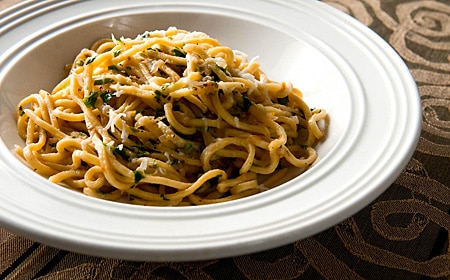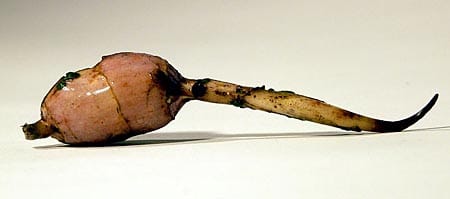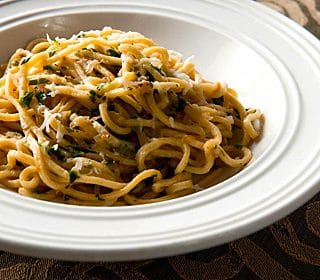As an Amazon Associate I earn from qualifying purchases.

Wapato, arrowhead, katniss, duck potato: Sagittaria latifolia and its cousins are aquatic tubers that live in American marshes. They are said to be every bit the equal of a potato. Sadly, I have never found it, despite quite a bit of searching. But my friend Sam Thayer sent me some wapato flour last week, so I finally got my first tantalizing taste of this elusive tuber.
Sam, as some of you may know, is the author of the two best foraging field guides I know of, The Forager’s Harvest and Nature’s Garden. He and I were supposed to venture into the swamps of his native Wisconsin this past October in search of wapato, but at the last minute something came up and we passed each other like ships in the night. I was bummed, because Sam says there are patches of wapato near him that stretch into the hundreds of acres.
Apparently the key to finding duck potatoes is to look for permanent marshes, which are not so common around here. Northern California can be one big swamp in winter, with all the flooded rice fields and wildlife refuges. But most of that dries up in summer, so the plant can’t survive. And I’ve never seen its distinctive leaves in the swamps of summer.
Arrowhead is actually a collection of species; the one with the largest tubers is Sagittaria latifolia. There are others, with smaller tubers, including S. rigida and S. cuneata. All are edible.
The plant gets it’s name from the leaves, which look like arrowheads. The tubers live in the muck under the water, and you need to get into that muck in September or so, disturb it with your feet, and hope to see the duck potatoes float to the surface. I’d planned to do this in duck hunting waders, but Sam prefers to strip down to bare feet to feel the tubers better. Chilly.
Once you get your potatoes, which can be anywhere from walnut-sized to the size of a good Yukon Gold, you wash them well, dry them and store in the fridge. To cook, you peel (or not) and cook just like potatoes. Sam makes his flour by boiling arrowhead, mashing it, drying it out, then grinding it in a spice grinder.
It looks exactly like yellow cornmeal, only not quite so yellow. Sam only had 1/2 cup of arrowhead flour to spare — just enough to tantalize me, to force me to venture back to Wisconsin next fall — so with so little flour to play with, I followed my first instinct: Make pasta with it.
Over the years I’ve learned you can put a little powdered anything into a regular pasta dough and it will work. I’ve done acorn flour, chickpea flour, chestnut flour, porcini powder, powdered garlic, tomatoes, etc. So I saw no reason not to make arrowhead pasta.
First I ground it even finer so it would incorporate seamlessly with the Italian “oo” flour I use. And since the wapato is yellowish, I thought I’d kick up the canary by making this an eggy pasta. In went 2 whole eggs plus 3 extra egg yolks. I wanted some bite to the pasta so I made it a spaghetti alla chitarra, with my chitarra pasta cutter — it looks like a funny mandoline or lute, and you roll the pasta dough through the “strings” of the “guitar,” which cuts the noodles. To release the pasta, you play the guitar. My chitarra has two sides, one for flat fettucine, one for a sort of square spaghetti; I chose the spaghetti side.
Sam says arrowhead tastes more or less like potatoes, with a slight bitterness (which is, apparently, mostly in the skin) and a faint corn-like sweetness. I had no idea what to expect. All I knew is that I did not want to drown the pasta in a heavy sauce.
Since wapato is also called duck potato, I thought I’d play with the duck part. It just so happens that gadwall, canvasbacks, geese, wood ducks, blue-winged teal, bluebills, ruddy ducks, ring-necked ducks, pintail and mallards all eat the seeds and/or tubers of sagittaria, so pretty much any duck we shoot in Northern California would work with them.
I decided to saute some finely minced shallot in wild duck fat, then added some wild duck demi-glace, the grated zest of a lemon, lotsa parsley, black pepper and a little grated pecorino cheese. I boiled the arrowhead pasta until it floated, let it boil another minute or so, then moved it to the boiling sauce and tossed to combine. Pretty simple.

Holly and I dug in and searched for the arrowhead flavor. I actually did catch a little of that corn-like sweetness, although I only identified it as an unusual sweetness when we ate. What was clearer was the texture of the pasta: Meaty, al dente like a dried pasta. This texture is pretty unusual in a fresh pasta, and we both liked it a lot.
So much so that I wish we had more to play with. Oh well. I plan on picking up my search for the elusive arrowhead after duck season. And I may yet get myself back to Wisconsin to see that wapato paradise Sam keeps talking about. Someday…
Arrowhead pasta with duck sauce
Ingredients
PASTA
- 1/2 cup arrowhead flour or extra-fine yellow cornmeal
- 1 1/2 cups Italian "oo" flour or all-purpose flour
- 1 teaspoon salt
- 2 whole eggs
- 3 egg yolks
SAUCE
- 2 tablespoons duck fat or butter
- 1/4 cup minced shallot
- 3/4 cup duck demi-glace
- Grated zest of a lemon
- 1/4 cup chopped parsley
- Salt and black pepper to taste
- Grated pecorino or parmesan cheese for garnish
Instructions
- To make the pasta dough, whisk together the two flours and the salt, then make a well in the center of the flour. Add the eggs and extra yolks and mix into a stiff dough. Knead for 5-10 minutes, until the dough becomes elastic. If you use wapato flour it will start out pretty sticky, then smooth out after a few minutes of kneading.
- Coat the dough with a little olive oil and cover in plastic wrap for at least 30 minutes; an hour is better. Roll out the dough in a pasta maker or with a rolling pin. Cut into long pasta. I use my chitarra to make a sort of square spaghetti, but you could make fettucine, linguine or the even wider pappardelle and it would still be good. Make sure you have plenty of flour to keep the noodles from sticking to each other.
- Don't make the sauce until you already have a large pot of salty water boiling. To start, saute the shallot in a large pan in the duck fat until the shallots just barely begin to brown. As soon as you see the edges start to brown, add the duck demi-glace. Now is the time to add the pasta to the boiling water.
- As the pasta boils, add the lemon zest and parsley to the boiling sauce. You want it to boil down almost to a glaze, which is why you do this in a large, wide frying or saute pan. When the pasta is ready, about 2 minutes, transfer it to the pan with the sauce with tongs. You actually want some of the pasta cooking water to come along for the ride. Toss to coat, let the liquid almost boil away and serve at once, garnished with grated cheese.
Nutrition information is automatically calculated, so should only be used as an approximation.
More Pasta Recipes
More Recipes for Unusual Starches, Tubers and Grains






I grew up in NorthEast Ohio. Arrowroot was common, but not in swamps. I found it most often in shallow streams. The stream that fronted my parents’ house had a wide, shallow & slow-moving stretch. Called Mud Run for the rich bottom of “muck”: fine soil, very high in organic content. For a mile or so downstream it was covered with the distinctive arrow-shaped leaves.
I never tried to harvest the roots, though. Storm sewers carried run-off from a large area of the city into the stream with the contaminants that can be washed off of a road. The arrowroot, also the crayfish, frogs & ribbon snakes that thrived among the shoots, seemed to cope with occasional muddy, rushing water several feet deep. The plant might loose part or all of the green tops, but within a few weeks it was back.
Wow you’re brave to try new things. Good for you!
Thanks for this post. I grew up near Tuckahoe Swamp in Virginia, named for this plant or a relative, and no live within easy reach of the Columbia River, where it’s called wapato, and was harvested in such huge quantities that it was traded regionally. Tribes once tended large gardens of this plant; not what westerners call agriculture, but maintaining the right kind of conditions and harvesting predictably year after year.
Sauvie Island near Portland was a huge wapato garden; there are accounts of women going out in the very cold water, filling up canoes with wapato. I suspect that as with many native species that were tended, once the people stop weeding, harvesting, and so on, the patches revert to a more diverse wild plant community. As an archaeologist, I look for concentrations of this and other food plants as clues for where sites may be, and possibly as traces of past “gardening.”
Kevin: Nope, never foraged for American lotus, but I’ve eaten it, and I like the nuts the best. The root is fine, but, well, you have to like lotus root. And I can take or leave it.
OregonCoast: You can dig the tubers where you are once the water recedes. They’re dormant now so you will get a lot of good flavor from them. In the north country they do it before ice-up.
Mike: They’re both awesome, and they cover different plants. But Nature’s Garden is thicker.
This recipe looks very delicious! I have to try this.
Hank,
the 2 books of Sams……if I can only buy 1, which one?
Regards,
Mike
It’s true, you know–find a shallow, sheltered bit of lakeshore and you’ll find them, all over Wisconsin. I haven’t been to many MN lakes, but I would imagine they’d be here too. I’ve heard that they’re edible, but thanks for the recipe. Any excuse to go boating is a good one!
Pretty sure we have these growing practically in our backyard… our neighborhood borders the extensive wetlands of Devils Lake near Lincoln City OR. Not only does it stay wet enough year-round– there are coho crossing our main road right now while it’s flooding! Typical January storm on the Oregon coast.
Can’t wait to go hunting arrowhead when it’s in season and try your pasta recipe.
There are several common species of Sagittaria here in the Southeast that I see quite often but hardly ever in massive stands. This post got me to thinking about other aquatic, tuberous plants. Hank, have you ever foraged for Nelumbo (Lotus) tubers? I can’t say that I haven’t thought about it but there’s usually a gator or two sunning next to them. What about the non-native wild taro/coco yam/elephant ear (Colocasia esculenta), does it have an edible tuber like the cultivated taro? I have seen large stands of it at man-made reservoirs.
I love everything about this! Rendered duck fat And Demi Glace! Pasta experiments with foraged foods. Kinda jealous…